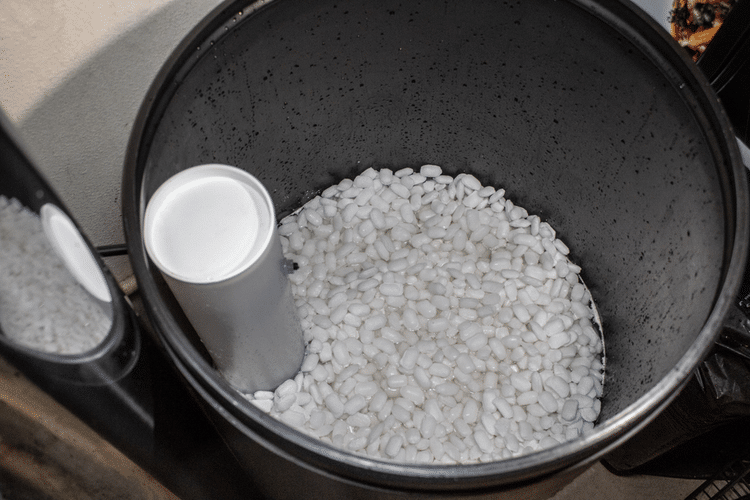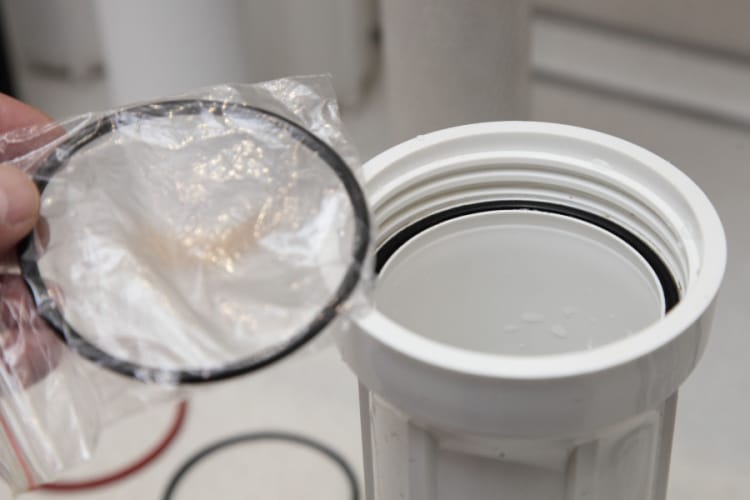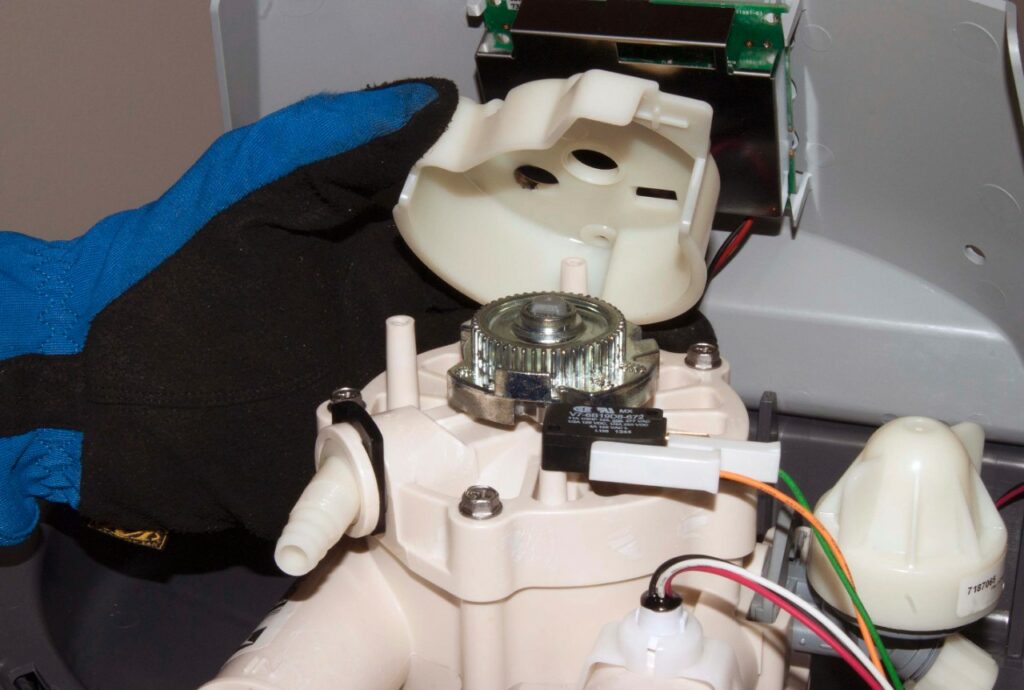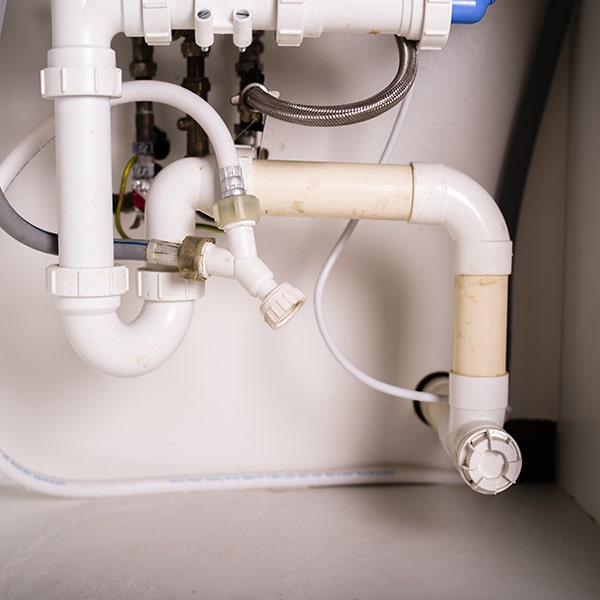You saw that your water softener is leaking, and you’re worried that you’re facing a problem you can’t possibly fix? The good news is that you shouldn’t be because there are easy fixes for every possible leaking scenario.
Softening devices are basically complicated water tanks that are connected to the piping system of your household, mostly via plastic lines. So, they’re likely to leak at some point, even if you purchased the best system on the market and maintained it impeccably.
Sometimes, these devices might leak from the top, due to a loosened-up bypass valve or from the bottom, due to a damaged drain line. There is also the possibility that the brine tank is overflowing with water because of a clogged brine hose or malfunctioning float valve.
That being said, not all those leaks warrant a call to the plumber, which might cost you hundreds of dollars per hour.
In this article, we’re going to go through every possible reason behind a leaking water softener, provide you with easy fixes for each, and tell you when it’s better to seek the services of a professional.
What Should I Do If I Suspect My Water Softener Is Leaking?
You saw a pool of water around the tanks of your water-softening system and started to suspect that there might be a leak somewhere, but don’t know what to do about it? Well, bypassing and then unplugging the device should be your first step.
If you have an old softener model that doesn’t have a valve, lever, or button for bypassing the unit, you may have to turn off the main incoming water line. We understand that this is not ideal, but that way, you’ll save water, stop the leak from expanding and flooding your home, and potentially prevent further damage to the device.
After that, you can check if the leak is coming from the top of the unit or the bottom. If you have a double-tank setup, we also recommend checking the brine tank first to see whether there’s an overflow issue.
If the leak is coming from the top of the unit, you have three potential reasons:
- The brine tank is overflowing,
- The o-rings of the bypass valve are worn out,
- The rotor valve at the top of the resin tank is cracked.
All of these problems are easy to deal with. However, if the leak is coming from the bottom, the severity of possible causes might cost you a lot, especially if the warranty period of the tanks is over. A leak from the bottom can mean:
- The brine tank is punctured or cracked,
- The resin tank is punctured or cracked.
In addition to these causes, there’s also the possibility that the root of the problem lies in one of the lines or hoses that the water passes through. If that’s the case, you’ll probably see that:
- The drain line through which the wastewater is flushed is loose or damaged,
- The brine hose that connects the resin and brine tank together is loose or damaged.
Once you identify which one of these is the reason behind your woes, you can start fixing the problem. Here’s what you can do to repair the leak depending on the root cause of the issue.
How to Stop Water Softener From Leaking From the Top
Overflowing Brine Tank

A brine tank that’s overflowing with water isn’t technically a leak because this simply means that a part of the water-softening system is clogged or damaged due to mineral buildup or salt clumps. Still, it will look like a leak, for all intents and purposes, from the top of the brine tank.
Here’s how to solve this issue based on why it’s happening:
- A clogged brine line that doesn’t allow the brine solution to be smoothly transferred to the primary tank can cause the water to accumulate inside the brine tank. Using low-quality salt or letting mineral residues build up within the systems might lead to clogged lines. You can confirm whether that’s the issue by emptying the brine tank, disconnecting the lines, and checking them for clogging. If there’s any sediment or salt, remove them and flush the line with water. Also, you should start using better-quality salt to prevent recurring issues and clean your water-softening device[1] every time you add new salt.
- A malfunctioning float control valve can allow too much water to enter the brine tank. Since the only function of the float control valve is to shut off the incoming water when there’s enough of it, it’s quite a likely factor behind an overflowing brine tank. In this case, you need to carefully take out the control valve and cleanse it thoroughly of any buildup and salt. However, if that doesn’t solve the problem, you should contact the manufacturer of the device.
- A clogged brine injector can’t suck water from the brine tank to direct it to the resin tank, resulting in an overflowing brine tank. A brine injector has many tiny holes that can easily be clogged by mineral or salt buildup. Luckily, it can easily be cleaned with a toothpick. Don’t use a needle, though, as it can damage the injector since these water-softener components are mostly made of plastic.
Clogging and malfunctions don’t always lead to leaks. Sometimes, their symptoms might appear as standing water inside the brine tank. You can learn more about that particular issue in our related guide: 10 Reasons for Standing Water in the Water Softener Salt Tank.
Worn-Off Bypass Valve O-Rings

Every piping system and water-related device has o-rings, and when they’re worn off, they can turn life into hell. That’s also the case for the o-rings that can be found on the bypass valves of water-softening systems.
O-rings require regular maintenance. They must be lubricated at least once a year to continue functioning at their best. However, even if you take care of them in an exemplary way, they’ll still eventually leak water due to wear and tear over the years.
If the bypass valve o-rings are the reason behind the leak, then they need to be replaced. As long as you have knowledge and experience in minor household plumbing and all the relevant tools, replacing the bypass valve o-ring can be a DIY-friendly repair.
However, if you don’t have experience in plumbing, it’s better to ask for professional help because getting the right-sized rings and mounting them properly is imperative to prevent them from leaking again.
Cracked Rotor Valve

The rotor valve is located at the top section of the resin tank, and it’s basically the gate through which untreated water enters the water softening unit. Since the water it’s exposed to is rich in minerals, it’s more prone to mineral buildup and related issues than other softener components. Especially when it’s old, the rotor valve is extremely likely to crack under pressure.
Sometimes there might be no visible cracks on the outside of the rotor valve, but water might still be leaking from it. In that case, the seals inside the valve are broken.
Whether the crack is on the outside of the valve or the seals inside, the rotor valve needs to be replaced. Before going out into the market, though, we recommend you contact the manufacturer of your device and learn how and where to get a replacement that’s suitable for the model of your device.
Let us also ease your mind by telling you that a replacement rotor valve isn’t expensive. They come in a range of $50 – $70.
How to Stop Water Softener From Leaking From the Bottom
Punctured or Cracked Brine Tank

The brine tank is where the salt that regenerates and cleans the resin goes. It can crack because of faulty manufacture, careless handling, or sloppy maintenance.
Sometimes, due to humidity, the salt inside this tank forms salt bridges, which need to be cleared with sharp and heavy tools like knives, hammers, and hand shovels. But be careful and gentle – if you use too much force, these tools can easily damage the brine tank, leading to a big leak.
Moreover, if the crack is due to your mishandling of the tank, the warranty is unlikely to cover the damages. It means that you will have to buy a replacement tank, which might cost between $150 – $250, depending on the material. Still, even if the warranty doesn’t cover the damages, you should contact the manufacturer to seek advice.
Some people prefer sealing the cracks with epoxy, but we don’t recommend it. You might not get it right and could further damage the system. More importantly, though, introducing foreign materials to a water treatment system means that you’re risking contamination.
Punctured or Cracked Resin Tank

Resin tanks may have punctures or cracks because of household accidents or because they’ve run their expiration time. When that happens, there’ll be a large body of water around the unit and a significant decrease in water pressure at your faucets.
The first course of action when the resin tank is damaged should be to call the manufacturer. Your warranty might not cover the damages, or it might have expired, but the manufacturer might still offer you solutions or discounts on a new tank.
Without a warranty, depending on the brand, a new resin tank costs around $500.
That said, if your water softener is old and you want to replace it altogether, we recommend you have a look at the Springwell SS1. Not only is it a highly capable and efficient system, but also Springwell offers a lifetime warranty on both tanks.
How to Stop Leakage from the Lines and Hoses of Your Water Softener
Damaged or Loose Drain Line

The brine solution that recharges and cleans the resin is discharged through a drain line. This drain line is connected to a different part of the plumbing so that the wastewater doesn’t end up in the main piping.
As the brine solution collects mineral residue and buildup from within the system and as it’s already a salty solution, it can wear off any lines it passes through. When the drain line is made of low-quality material, it might easily get damaged over time, and you’ll need to replace it.
Additionally, the drain connections might come loose due to improper plumbing, worn-off connectors, or because of a mistake. A quick fix would be to tighten the connectors. If the leak doesn’t stop when you do it, they’ll need to be replaced, too.
In such cases, calling the manufacturer to learn their replacement recommendations is a good idea. Then, you can purchase the part they recommend and replace the damaged drain line or faulty connectors. If you don’t have faith in your plumbing abilities, you may seek professional assistance.
Damaged or Loose Brine Hose

Similar to the drain line, the brine hose of the system might come loose after a while. Or, it might suffer damages like punctures and cracks due to accidents or simply because it’s become worn out after years of service.
The recommended course of action for a damaged brine hose is similar to what we established as a solution for a damaged drain line in the previous section. If the leak is due to damage to the hose, call the manufacturer, ask for a recommendation, and replace it.
If the leak is in the connection, tighten the connectors. If that doesn’t help, you need to replace them, too.
Conclusion
A water softener system might leak because its brine tank is overflowing, its bypass valve o-rings are defective, its rotor valve is cracked, either of its tanks are punctured, or lines and hoses have come loose or suffered damages.
An overflowing brine tank, defective o-rings, or cracked rotor valve are all problems that have easy fixes. However, if the tanks are punctured, they need to be replaced, which might turn out quite costly.
If the drain line or brine hose is loose, the solution might be as easy as tightening the connections. When that’s not effective, it means that these parts need to be replaced as well.
Having established all that, you might have realized that the leaks happen because the system itself is old. So, it might be time to look for a new system, and we’re well-prepared for that. Check out our guide on the Best Water Softener Systems: Top Picks for 2022 to choose the right system for your needs.
link to how to clean water softener when live.